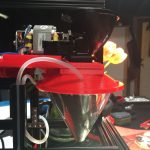Raspberry Pi Feeds the IoT and Maker Trends
October 16, 2017
“Mugsy is the coffee maker of your dreams,” according to a recent Hackster.io blog discussing the IoT device. Mugsy configures grind size, water temperature and even bean-based brew settings using cloud computing and machine learning. Unfortunately, Mugsy is not available at Bed, Bath and Beyond: caffeine connoisseurs need one Raspberry Pi (not the food) and one Arduino (not an animal) to get this perfect cup of joe.
These two tools lead IoT innovation and the Maker Movement. A Raspberry Pi is a general-purpose, system-on-a-chip (SOC) computer. The size of a credit card, it costs only $35. On its third generation, the system has 1GB of RAM and a 1.2Ghz Quad Core Broadcom 64bit CPU. All Raspberry Pi computers run an OS, usually the Raspbian version of Linux, from an SD card.
They are powered via USB and have connections for a mouse, a keyboard and TV or monitor. All Raspberries are equipped for a Wi-Fi adapter. They have other I/O ports available for sensors and other physical devices, which makes the system ideal for smart networks using sensor technology. The computer is primarily coded using Python.
Raspberry Pi Foundation designed the computer to reignite a passion for programming in kids. Creators saw that young people today do not experience coding the same way their parents did in the 1990s. By being affordable, accessible, and easy to use, the Raspberry Pi makes computing-based development easy and fun. Eventually, people realized the Pi is useful beyond education in the classroom. Hobbyists have used this cheap, effective computer in incredible ways and novel projects.
In the IoT and Maker worlds, Raspberry Pi is the number one tool used for computing. However, for smaller, repetitive task projects, the Arduino offers an open-source hardware/software solution complete with its own programming language. It’s a microcontroller motherboard that runs one program at a time. A general rule of thumb for choosing Arduino vs. Raspberry Pi is the “two ands” rule: if it takes more than two ands to describe your projects tasks, use Raspberry Pi.
Both computing tools are designed for beginners and kids. However, people of all ages can use them. For coffee snobs, building your version of Mugsy could be just around the corner with a Raspberry Pi or Arduino kit. If the perfect cup isn’t for you, try applying this technology to your personal interests.